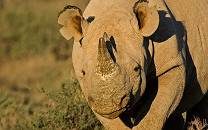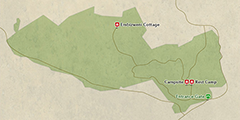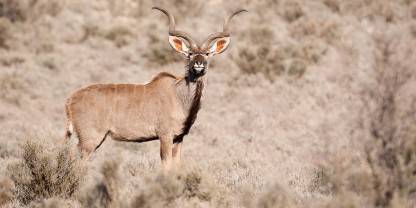The Great Karoo, the largest ecosystem in South Africa, doesn’t appear to be anything more than vast nothingness to people driving between Johannesburg and Cape Town. Most of the wildlife that once roamed here has been eradicated, but Karoo National Park is a relatively small area where this unique habitat and its animals are protected.

-
Best Time To Go
- Aug, Sept, April, May (Mild weather)
-
High Season
- Never (The park never gets crowded)
-
Size
- 831km² / 321mi²
-
Altitude
-
783-1,821m /2,569-5,974ft
 View Photos
View Photos
 View Photos
+19
Photos
View Photos
+19
Photos
 Open Map
Open Map
Pros & Cons
- Dramatic, rugged landscape
- Excellent birding including Karoo specials
- Very rich reptilian fauna, including five tortoise species
- Fossil trail depicting geology and paleontology of the Great Karoo
- Night drives and guided walks available
- Scenic drives for all vehicles and dedicated 4x4 tracks available
- Convenient stopover between Johannesburg and Cape Town
- Self-catering accommodation and restaurant
- Not many typical safari animals present
- Far away from South Africa's main tourist attractions
- Very hot conditions and harsh environment
Wildlife
Karoo National Park is primarily a wilderness destination. Although it is home to a variety of wildlife, many typical safari animals are absent. Two of the Big Five have been re-introduced: lion and black rhino, but they are only occasionally seen. Large herbivores to look out for are red hartebeest, black wildebeest, eland, Cape mountain zebra, kudu and springbok. Klipspringers are regularly seen on the pass of the same name.
More about Karoo National Park’s wildlifeScenery
Karoo National Park is dominated by the Nuweveld Mountains and rolling plains. The scenery looks harsh in the midday sun but, towards late afternoon, the subtleties of the landscape reveal themselves when the shadows add detail and the pastel colors soften the empty environment.
Weather & Climate
Drought often exacerbates the dry winter (May to September) at Karoo NP. This can be accompanied by bitterly cold conditions at night, with temperatures never really heating up that much in the daytime. The summer (October to April) doesn’t see that much rain either. It mainly arrives in the form of occasional showers and storms. These months are also characterized by hot days, with the average daytime temperature around 33°C/91°F.
More about the weather and climateBest Time To Visit
Karroo National Park can be visited throughout the year. Animals can be seen anytime. The summer months (October to April) are hot during the day but lovely in the early morning or late afternoon. Winter (May to September) might be a more attractive option, assuming you don’t mind warding off the cold when the sun goes down.
More about the best time to visit
